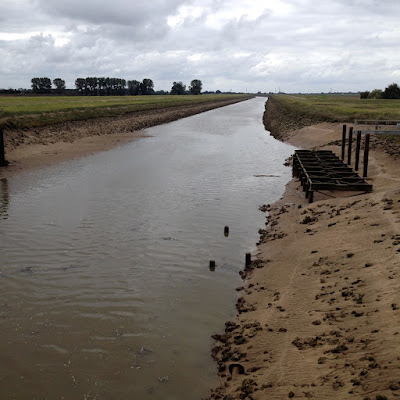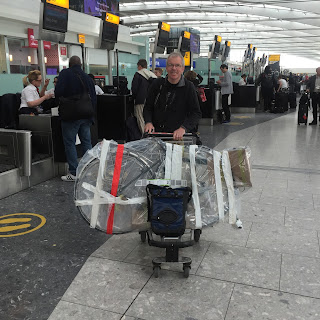I had reached King's Lynn at the end of July, where I had caught a train back to London, leaving the North Sea coast free for holidaymakers during the school holidays. It was the end of the first week in September when I started off again, catching the train back to King's Lynn and cycling off along the course of the old A17. This is a trip I've made many times and I didn't feel the need to take the detours that the NSCR takes to avoid traffic. I almost regretted this decision as the heavy lorries hurtled past me on the A17 between Saracen's Head and Fosdyke, but it was soon over and I was back among fields full of cabbages again. I should say here that although I raced through this part of the journey it's well worth making a few stops to see some of the astonishing fenland churches, especially the one at Walpole St Peter.
 |
| River Welland at Fosdyke Bridge |
 |
| Cabbages |
On the way to Boston I found another dyke, but this one was made getting on for 2000 years ago by the Romans. It looks just like the ones in Germany though, only smaller. Behind the dyke there were plenty of cabbage fields, with the occasional mobile packing station moving slowly along the rows. Then I was in Boston, a town which has changed enormously in the 20 years since I first went there. Immigration from Eastern Europe is a big deal around here, but these fruit and vegetable picking areas have always depended on migrant labour. it used to be gypsies and travellers and students who did the seasonal work. I even picked a few strawberries myself back in the 1960s. Now it's people from Eastern Europe who do the work, and Boston is their new centre, with specialist shops everywhere.
 |
| Baltic Shop, Boston |
In the 1960s my mum worked in a school on the fens. It was a tiny, two teacher primary school and at fruit picking time half the kids went off to work in the fields. The head teacher had a canning machine in the school and he spent the summer days canning fruit.
I was heading for Skegness, mainly because I'd never been there. At Boston I deviated from the NSCR again. It goes North-west here through Lincoln, and it's a lovely way to go, but I decided to stick to the coast on this bit and take in Grimsby, another place I'd never been.
 |
| Out-of-season cafe in Skegness |
 |
| Car park and caravan site, Skegness |
I camped near Skegness, which appeared to be one vast caravan site, and carried on next day along the coast through Mabelthorpe where the streets were thronging with people on mobility scooters but I got a very good cup of coffee in an Italian coffee bar.
 |
| Mabelthorpe |
North of Mabelthorpe the coast starts to curve round towards the mouth of the Humber river, and eventually I reached Cleethorpes and Grimsby which are kind of joined together. I cycled past the semi-derelict fish docks in Grimsby and wondered why the small coastal towns of Norway and Denmark all seemed to have thriving fishing, while Grimsby and Lowestoft now have very little. I also remembered passing another Grimsby on the South-west tip of Norway.
 |
| Old fish docks, Grimsby |
I was hoping to camp in Barton-upon-Humber, at the southern end of the Humber Bridge, but the campsite had been washed away by floods and after a lot of fruitless cycling around (20 years ago Barton had three campsites - now there are none) I had to resort to a hotel. It was very comfortable.
 |
| Full English Breakfast (minus the sausage) |
The next morning I crossed over the bridge into Yorkshire.
 |
| The Humber |
Tips:
- Churches in England are almost always worth visiting. They are not always open, but someone close by usually has the key. In the fens near King's Lynn the churches can be spectacular.












Comments
Post a Comment